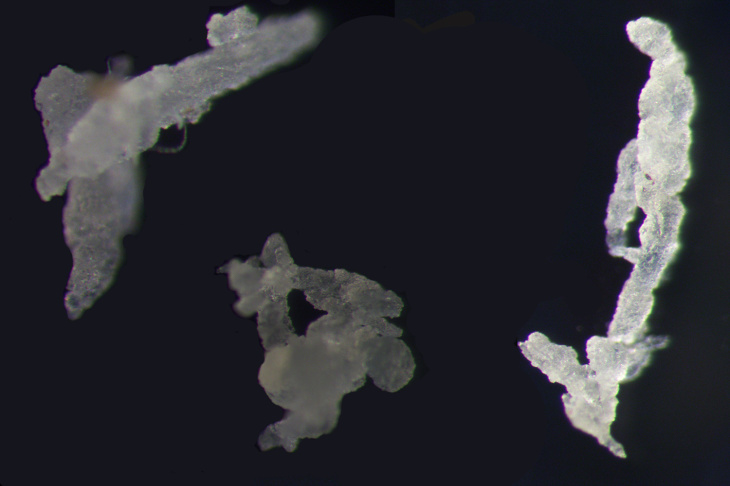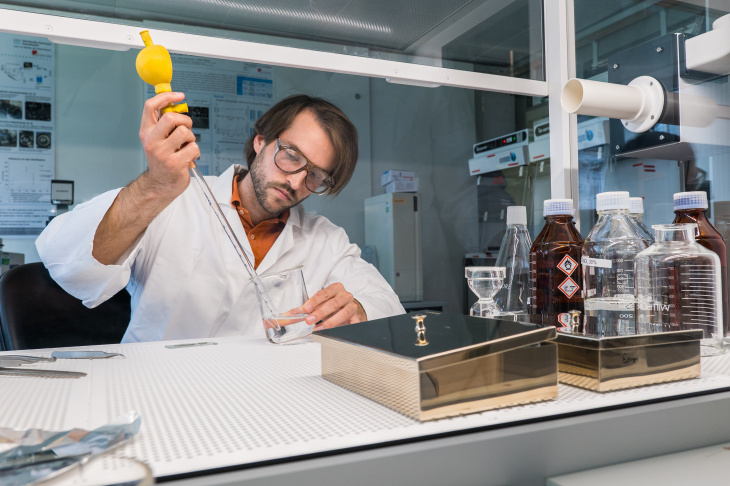Microplastics in the Elbe River
Please note: Since the 31st of March 2021 the Helmholtz-Zentrum Geesthacht – Center for Materials and Coastal Research has a new name: Helmholtz-Zentrum Hereon. More information www.hereon.de/name
A team of scientists under the direction of the Helmholtz-Zentrum Geesthacht – Centre for Materials and Coastal Research (HZG) has detected numerous microplastic particles in the Elbe waters near Cuxhaven. The researchers found 200 to 2100 microplastic particles per cubic meter of water. To better interpret the results of their measurements and their large range as well as to enable the scientists to make comparisons with future studies, the team demonstrated for the first time in the field of microplastics research how the guidelines of the International Bureau for Weights and Measures (BIPM) can be applied to determine measurement uncertainty in such tests. The study, which was published today in the Journal of Hazardous Materials with a methodology for presenting and calculating the results that can also be applied to many other studies, shows that the previously known microplastic concentrations likely exhibit a very high level of uncertainty.

Microscope images of ethylene propylene diene monomer rubber (EPDM) particles. This plastic is used a lot in industry, for example for seals in water armatures, for cable sheathing, for sealing roofs and facades or in the construction of cars and appliances. The three particles shown are the largest particles and are about 700 to 1000 micrometres long. Photo: Hildebrandt et al. 2021
According to estimates, the Elbe transports between 300 kilograms to 1.2 tons of plastic waste every day to the North Sea (Schöneich-Argent et al., 2020), but the real number is estimated to be significantly higher. Scientists from the newly founded Institute of Coastal Environmental Chemistry at the Helmholtz-Zentrum Geesthacht (HZG), the Alfred Wegener Institute – Helmholtz Centre for Polar and Marine Research (AWI) on Helgoland and the Leibniz Institute for Polymer Research Dresden (IPF) have studied the surface waters at the HZG’s measurement station in Cuxhaven to compare various sampling methods and to determine the quantity of microplastic particles that end up in the North Sea via the Elbe.
The methods, which have so far been used for particle sampling, are often problematic in that the filters utilized clog up too quickly and only small volumes of water can be sampled. This affects the representativity of the results. Therefore, in addition to the bulk samples taken, the samples in the current study were obtained for the first time using two alternative techniques: continuous-flow centrifuges and hydrocyclones. Both are well-established instruments in other fields for continuous separation of particles from large volumes of liquid. “We got a relatively large amount of particulate matter in the water from the tides on the North Sea coast. We therefore first needed to cleanse the water samples of organic material and sediment particles. We then analyzed some of the samples using microspectrocopic methods at the IPF and at AWI. Through the systematic procedure, we wanted to obtain results that were as comparable as possible,” explains Lars Hildebrandt, environmental chemist and first author of the study.
The result was that “we found between 200 and 2100 microplastic particles per cubic meter of water. Around 95 percent of those are smaller than a hundred micrometers, approximately the diameter of a human hair,” says Hildebrandt. “Those are relatively high concentrations in comparison to the open North Sea.” The particles most commonly identified were polypropylene, acrylate, polyvinyl chloride and polyethylene. The different types of plastics are essentially found in highly varying products, which makes it difficult to clearly assign the found particles to the products. Polypropylene and polyethylene are common packaging materials. Forty percent of all plastic production goes into packaging with a short product lifecycle. PVC (polyvinyl chloride) is found in large quantities in the construction industry, such as in flooring or wiring. Acrylate is found in coatings and paints, but also in many cosmetic products.
How certain are such results?

HZG doctoral student Lars Hildebrandt prepared all samples for the final analysis in the laboratories of the Institute for Coastal Environmental Chemistry in Geesthacht. Photo: HZG/Steffen Niemann
For the first time, the scientists applied the most important guideline for ascertaining measurement uncertainties for evaluating the studies: The Guide to the Expression of Uncertainty in Measurement by the International Bureau for Measurements and Weights. This is the most important body worldwide on measurements and weights. It oversees the International System of Units and all forms of measurements. Lars Hildebrandt explains, “Every measurement type is subject to uncertainty, which is specified together with the measured value, known as measurement uncertainty. Many published studies on microplastic particles, however, do not apply the relevant guidelines, which may incorrectly give the public an impression of accuracy: ‘These are the concentrations and nothing else.’ However this is not the reality. We encounter this problem in other areas of everyday life as well: for example, when you look at the nutritional information on a cheese package or try to buy exactly two kilograms of potatoes at the weekly market.”
Applied to the Elbe results, the uncertainty analysis shows that the measurement values are partially subject to extremely high uncertainties (from around 25 percent to up to 200 percent). “The main source of these uncertainties for our studies as well as for all other studies is that the distribution of microplastic particles in the Elbe waters is not uniform—the particles fundamentally behave differently than dissolved substances. The researchers therefore must adequately calculate the measurement uncertainty, which naturally also results from the sampling and analysis methods used in addition to the inhomogeneous distribution in the environment, and take it into account when publishing the final results. ¬It often turns out that the patterns found in the transport and distribution of microplastics in the water do not differ significantly from one another within the measurement uncertainties,” says Dr. Daniel Pröfrock, head of the department of Inorganic Environmental Chemistry at the HZG.
Optimization and Standardization
“The issue of microplastic particles in our waters is scientifically in its infancy,” points out environmental chemist Dr. Tristan Zimmermann, co-author of the study. “We need representative sampling techniques to validate the state of the environment. These techniques must be analytically accurate, comprehensible and robust, must have a high degree of automation and also be time and cost efficient.” In the future, corresponding uncertainty assessments should also be carried out as a standard in the context of microplastic studies in order to improve the comparability of data from different studies and to be able to provide a more solid data basis for decisions derived from them. Using their new methods, HZG researchers took samples in the Atlantic last December from the SONNE research vessel in order to elucidate the situation in other parts of the ocean. These samples are currently undergoing analysis in the HZG’s laboratories at the Institute of Coastal Environmental Chemistry.
Original Publication
- Lars Hildebrandt, Tristan Zimmermann, Sebastian Primpke, Dieter Fischer, Gunnar Gerdts, Daniel Pröfrock Comparison and uncertainty evaluation of two centrifugal separators for microplastic sampling, Journal of Hazardous Materials, Volume 414, 2021, 125482, ISSN 0304-3894, doi.org/10.1016/j.jhazmat.2021.125482.
Further Informationen
- Inorganic Environmental Chemistry Department website
Contact

Inorganic Environmental Chemistry
Institute of Coastal Environmental Chemistry
Helmholtz-Zentrum Geesthacht

Communication and Media
Helmholtz-Zentrum Geesthacht
